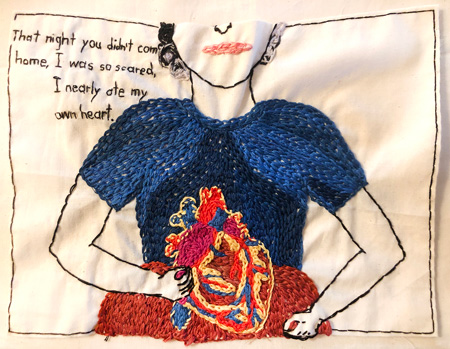Unartisanal ||
Back to exhibition
Iviva Olenick
What draws you to the materials you work with?
Working with fiber feels like translating the lived experience of the body into a tactile form others can see. I think the medium conveys a sense of touch, even when viewers cannot touch the artworks. Also, given the long history of textiles and their connections to agriculture, foundational labor in the U.S. and around the world, they embed cultural mythologies, secrets and aspects of history we often try to sweep under the rug, like long-term impacts of foundational enslaved labor on race relations and life expectancy for people of color.
Why "craft" and not "art"?
I don't consider my work craft in that I am not making objects for functional use, even though I am using a set of materials and processes often categorized as craft. I consider my work art because it participates in conversations and concerns among contemporary artists and art institutions.
In what ways are you expanding upon the realm of craft?
Although not referenced in my attached artworks, I have been growing colonial textile crops for several years in New York City at several public farms and gardens, including Old Stone House & Washington Park in Brooklyn, and GrowNYC's Governors Island Teaching Garden. I've watched cotton survive through a New York winter, the bolls split wide open with fiber spilling out onto the soil. I've harvested indigo and spent whole days fermenting leaves to make dye, and leading workshops with adults and children. I believe these plants embed social and cultural histories, including the traumas of the people who cared for and grew them (in reference to enslavement). By growing these crops in an unexpected urban environment, I hope to open people's interest in and curiosity about the literal roots of textiles, and the histories they convey and embed, including social and cultural rituals from around the world, and foundational enslaved labor in the U.S. In short, I hope to make the invisible visible.
Is your work rooted in any specific traditions or techniques?
Most of the work I exhibit, including the attached images, is embroidered. Occasionally, I embroider or make fabric sculptures from hand-dyed fabrics. I am self-taught in both processes, and therefore hesitate to say I work in a specific tradition. When I grow indigo, from which I make dye, I reference the origins of the dyeing methods, which are adapted from contemporary dyers, who themselves often learned methods traditional to Africa, Korea, Latin America and/or Japan. I would say that many contemporary dyers use methods that combine or borrow from multiple countries of origin and cultures, as colonialism, trade and most recently the internet (have) convey(ed) technical knowledge across geography, culture and time.
How do you navigate "craft" while avoiding popular trends?
I have a strong internal sense of what I consider interesting or important. My embroideries are an analog blog, a way of trying to assuage human reliance on digital communications with a need to live in the body through immersion in hands-on craft. While I recognize that I am not alone in this interest, I like to think that my voice as a writer, which comes through in my work literally as text and visually as narrative illustrations, distinguishes me from trends, such as re-creating text messages and tweets to visually resemble the digital iconography versus crafting a new visual and verbal vocabulary to talk about the interstices of human connection, and the quiet parts of being that are often unspoken or unarticulatable.
Do you consider craft utilitarian, or decorative, or both/neither? Why?
I think of craft as utilitarian and decorative. When I visit the South, the art galleries show hand-thrown pottery, glass, fiber in the form of decorative and usable vases, dishware, quilts, etc. These works speak to the development of craft in the South as both decorative and utilitarian, and the passing down of traditions of making and using materials.
Why do you think so many people are returning to fiber arts these days?Fiber arts includes a range of processes that can be done safely at home (knitting, crochet, weaving, embroidery). The scale can range from handheld to billboard-sized, and the materials are accessible and non-toxic (except for some chemicals used in dyeing). In addition, fiber arts processes can be soothing and stress-relieving. As our lives become more digital instead of tactile, using one's hands to make an object for oneself or another to use can feel familiar, comforting and satisfying. Additionally, with so much time spent at home during quarantines and lockdowns the past year, taking up a craft like knitting, weaving or sewing seems like another version of baking sourdough: it's finally time to try that thing I've been thinking about and never tried...
How has the pandemic affected your practice?
I was about to say that I have more time, but really I have a different kind of time. Instead of commuting, I walk from my bedroom or kitchen to my desk. Without the small stresses of local travel, I can attend to more internal thoughts more regularly as I'm in a quiet, domestic setting most of the time. As my teaching and my schedule have become more varied, the call to make work in my downtime has become more insistent. As an artist, the forced time alone has been productive, and while I mourn the freedoms of movement and socializing we had before the pandemic, I would be remiss if I did not acknowledge the fact that I have dug into my work with renewed vigor and commitment. In the end, making my work becomes a commitment to my personal growth rather than a purely professional endeavor, although external validation can also feel good.
Unartisanal is funded in part by the New York State Council on the Arts and the
New York City Department of Cultural Affairs
Unartisanal ||
Back to exhibition

